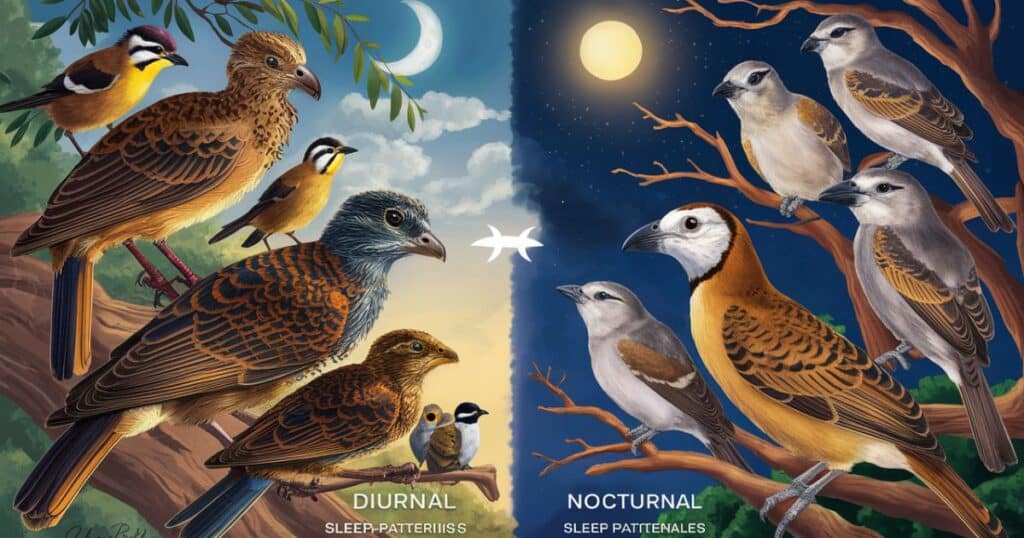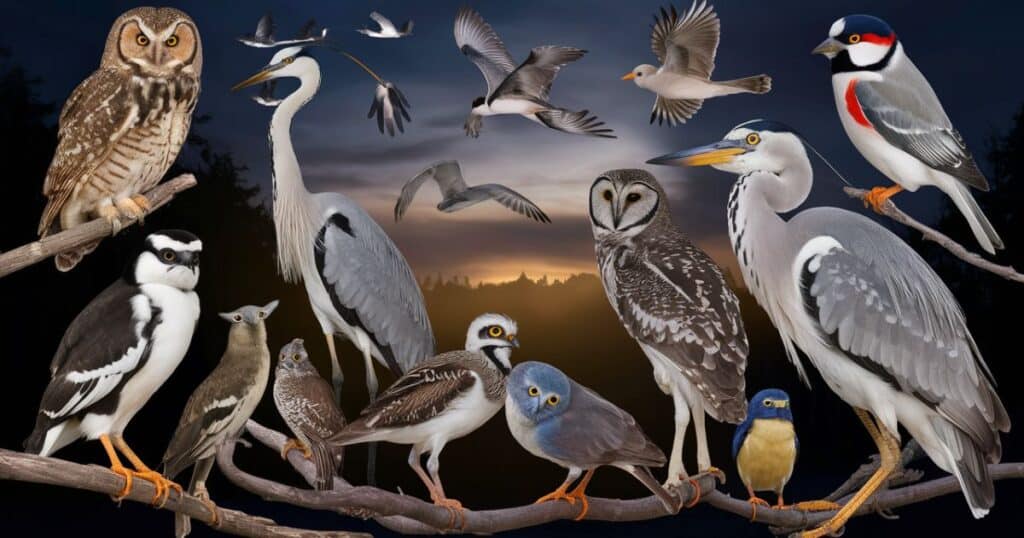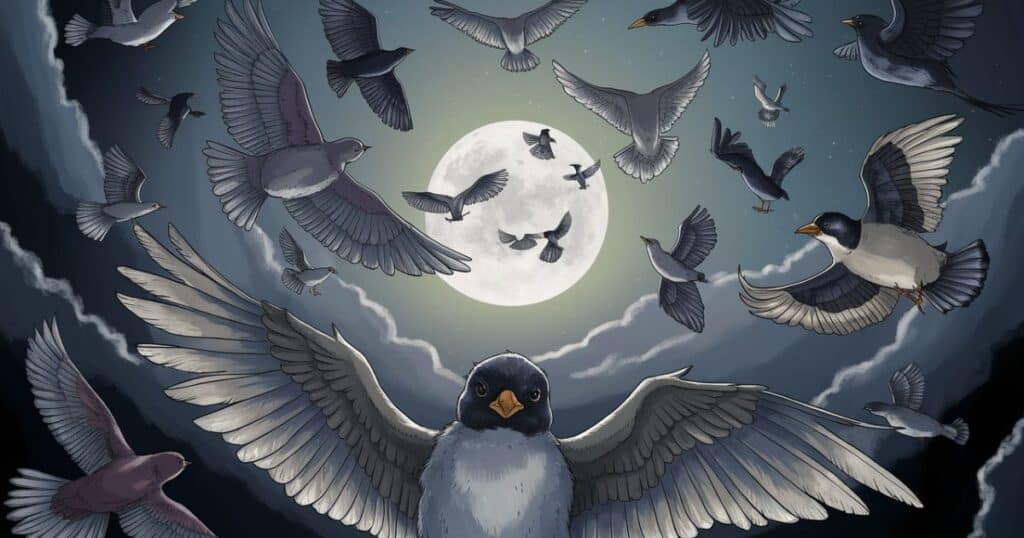Have you ever wondered what happens in the avian world when darkness falls? While many birds settle down for the night, some species take to the skies, defying the constraints of daylight.
This comprehensive guide delves into the intriguing realm of nocturnal birds, exploring their unique behaviors, adaptations, and the implications of their nighttime activities.
Diurnal vs. Nocturnal Species: Do Birds Sleep at Night?

The majority of bird species are classified as diurnal, meaning they are active during the day and sleep at night. However, the avian world is diverse, and not all feathered friends adhere to this pattern. A smaller subset of birds, known as nocturnal birds, have evolved to thrive in the darkness, hunting, migrating, and carrying out various activities under the cloak of night.
Why Don’t You See Birds Flying at Night?
If you’ve ever taken an evening stroll or driven along a quiet road at night, you may have noticed a distinct absence of birds in flight. There are several reasons why most bird species avoid flying after sunset:
- Superior Daytime Vision: Birds have excellent eyesight adapted for daytime conditions. Their eyes are designed to detect movement and perceive colors vividly during the day, but they struggle with low-light conditions at night.
- Reduced Risk from Predators: Flying at night increases the risk of falling prey to nocturnal predators like owls or bats, which have superior night vision and hunting abilities. By staying grounded, birds minimize this threat.
- Energy Conservation: Birds conserve energy by resting and sleeping at night, reserving their strength for the demands of daytime activities like foraging, nesting, and territorial defense.
MORE POST: Is A Bird A Mammal? Exploring The Avian Classification
Are Birds Scared at Night?
While fear may play a role in some species’ aversion to nighttime activities, most birds simply follow their innate biological rhythms. Their circadian cycles are adapted to be active during the day and rest at night, much like humans and other diurnal creatures. However, certain birds, like the American Robin, can exhibit behaviors that suggest fear or discomfort in low-light conditions, such as seeking shelter or becoming more vigilant.
How Long Do Birds Sleep?
The duration of sleep varies among bird species, but most birds sleep for a significant portion of the night. Here are some examples:
- Songbirds: Typically sleep for 10-12 hours per night, with intermittent periods of wakefulness.
- Waterfowl: Ducks and geese may sleep for up to 16 hours per day, often resting on the water’s surface.
- Raptors: Birds of prey like hawks and eagles tend to sleep for shorter periods, averaging 8-10 hours per night.
It’s important to note that birds have the unique ability to sleep with one eye open and one hemisphere of their brain awake, a phenomenon known as “unihemispheric slow-wave sleep.” This adaptation allows them to remain vigilant and responsive to potential threats even during rest.
Where Do Birds Sleep at Night?
Birds have adapted various strategies for finding safe and comfortable roosting spots to sleep at night. Here are some common locations:
- Tree Cavities: Many bird species, such as woodpeckers and nuthatches, seek out natural cavities in trees or abandoned nests for shelter and protection.
- Dense Foliage: Birds like sparrows and finches often roost in thick shrubs or evergreen trees, tucking themselves into the densest parts for warmth and camouflage.
- Nest Boxes and Birdhouses: Provided by humans, these artificial structures offer safe havens for birds to rest and raise their young.
- Ledges and Overhangs: Urban-dwelling birds like pigeons and swifts may roost on building ledges, overhangs, or in crevices, taking advantage of man-made structures.
- On the Ground: Some ground-dwelling birds, like quails and certain shorebirds, simply settle on the ground for the night, relying on their camouflage and vigilance for safety.
What Time Do Birds Go to Sleep?
The timing of when birds retire for the night can vary depending on the species and the time of year. Generally, most birds settle in for the night shortly after sunset, with some species seeking their roosting spots up to an hour before dusk. However, during the breeding season or when caring for young, some birds may delay their sleep to attend to their nests or continue foraging.
Why Can I Hear Birds Singing at Night?
If you’ve ever been awoken by the melodious songs of birds in the middle of the night, you’re not alone. While most bird species are silent at night, there are a few exceptions that vocalize after dark:
- Territorial Defense: Some male birds, like the Northern Mockingbird and Song Thrush, may sing at night to defend their territories and advertise their presence to potential rivals.
- Attracting Mates: During the breeding season, some species like the Eastern Whip-poor-will and Common Nighthawk engage in nocturnal singing to attract mates or maintain pair bonds.
- Communication During Migration: Migratory birds may call out to each other while flying at night, using vocalizations to maintain contact with their flock or navigate their routes.
Do Birds Fly at Night?
While the majority of bird species strictly adhere to diurnal routines, there are several exceptions that take to the skies after sunset, defying the constraints of daylight.
Why Do Some Birds Fly During the Night While Others Don’t?
The ability to fly at night offers certain evolutionary advantages for some bird species:
- Hunting Opportunities: Nocturnal birds like owls and nightjars have evolved exceptional night vision and silent flight abilities, allowing them to hunt prey more effectively under the cover of darkness.
- Safer Migration: For migratory birds, flying at night can reduce the risk of predation and exposure to harsh daytime conditions like heat or dehydration.
- Energy Conservation: Some species, such as the Common Nighthawk, have adapted to fly and feed on insects during the cooler nighttime hours, conserving energy during the day.
- Reduced Competition: With fewer diurnal birds active at night, nocturnal species can exploit resources with less competition, such as prime roosting or nesting sites.
Do Only Nocturnal Birds Fly During the Night?
No, nocturnal flight isn’t limited solely to strictly nocturnal species. Some birds classified as crepuscular, meaning they are active at dawn and dusk, may also take advantage of flying during nighttime hours.
Examples of crepuscular birds include:
- Allen’s Hummingbirds
- White-Eared Hummingbird
- American Woodpecker
- Black-crowned Night-Heron
These species may fly at night for various reasons, such as foraging, commuting between roosting and feeding sites, or engaging in courtship displays.
Is It Normal for Birds to Fly at Night?
While not the norm for most species, nocturnal flight is a natural behavior for certain birds that have adapted to the conditions of the night. It’s important to remember that these birds have evolved specialized traits, such as enhanced night vision, silent flight, and unique hunting strategies, to thrive in the darkness.
During Migration
One of the most remarkable examples of nocturnal avian behavior is the phenomenon of bird migration. Many migratory bird species take advantage of flying at night during their long journeys, benefiting from several advantages:
- Cooler Temperatures: Nighttime temperatures are generally cooler, reducing the risk of dehydration and heat stress during extended flights.
- Fewer Predators: With fewer diurnal predators active at night, migratory birds can travel more safely, especially over long distances.
- Calmer Winds: Winds tend to be more stable and consistent at night, providing better flying conditions for birds navigating their migration routes.
- Celestial Navigation: Stars and celestial cues can aid birds in maintaining their orientation and navigation during nighttime migration.
Some well-known examples of migratory birds that undertake nocturnal flights include:
- Warblers
- Thrushes
- Sparrows
- Shorebirds
- Waterfowl
While flying at night presents its own challenges, such as navigating in low-light conditions and avoiding obstacles, many migratory species have evolved adaptations to overcome these hurdles, ensuring successful journeys to their breeding and win.
Common Nocturnal and Crepuscular Birds

Now that we’ve explored the reasons behind nocturnal avian behavior, let’s take a closer look at some of the most fascinating nocturnal and crepuscular bird species:
Nocturnal Birds
These birds are adapted to thrive in complete darkness, with exceptional night vision, silent flight, and specialized hunting techniques.
Owls
Owls are perhaps the most well-known and iconic nocturnal birds. With their exceptional night vision, silent flight feathers, and acute hearing, owls are perfectly suited for hunting at night. Some notable owl species include:
- Great Horned Owl: A powerful predator with excellent low-light vision and distinctive ear tufts.
- Barn Owl: Known for its ghostly appearance and ability to locate prey using sound alone.
- Burrowing Owl: A unique owl species that nests underground and hunts for small mammals and insects at night.
Nighthawk
The Common Nighthawk is a fascinating crepuscular bird that feeds exclusively on insects caught in mid-air during dusk and dawn hours. Their erratic, bat-like flight patterns and distinct nasal “peenting” calls are a familiar sight and sound in many urban and rural areas at night.
Nightjar
Nightjars, like the Eastern Whip-poor-will and Chuck-will’s-widow, are well-camouflaged ground-dwelling birds that emerge at night to hunt for insects. Their distinctive calls, often heard on warm summer evenings, are a hallmark of the nighttime soundscape in many regions.
Crepuscular Birds
Crepuscular birds are active during the twilight hours of dawn and dusk, but some species may also engage in nocturnal activities:
Allen’s Hummingbirds
These tiny hummingbirds are known for their exceptional ability to see and navigate at night. They are one of the few hummingbird species that actively feed and breed during the early morning and evening hours.
White-Eared Hummingbird
Similar to Allen’s Hummingbirds, the White-Eared Hummingbird is a crepuscular species that takes advantage of the cooler temperatures and reduced competition during the twilight hours.
American Woodpecker
While most woodpeckers are diurnal, some species like the Pileated Woodpecker are known to forage and drum on trees during the early morning and evening hours, extending their activities into the crepuscular period.
Black-crowned Night-Heron
As the name suggests, this heron species is primarily active at night, hunting for fish, crustaceans, and other aquatic prey in wetlands, marshes, and coastal areas.
Flight Habits of Common Backyard Birds

While many of the birds we encounter in our backyards and urban areas are diurnal, there are a few species that may exhibit occasional nocturnal or crepuscular behaviors:
American Robin
The beloved American Robin is generally a diurnal species, but during the breeding season, male robins may sing their beautiful songs throughout the night to defend their territories and attract mates.
Blue Jay
While predominately diurnal, Blue Jays have been known to engage in nocturnal activities, such as flying and vocalizing at night, especially in areas with high artificial lighting.
Northern Cardinals
These vibrant songbirds are typically active during the day, but they may occasionally sing or fly at night, particularly in urban areas or during the breeding season.
Implications and Conservation
Understanding nocturnal avian behavior and the unique challenges faced by night-flying birds is crucial for their conservation and protection.
Habitat Protection and Restoration
Preserving natural habitats, such as forests, wetlands, and grasslands, is essential for providing suitable roosting and nesting sites for nocturnal and migratory bird species. Restoring degraded habitats can also aid in supporting these birds’ needs.
Reduce Light Pollution
Artificial lighting from urban areas, streets, and buildings can disrupt the natural rhythms and behaviors of nocturnal birds. Implementing measures to reduce light pollution, such as using shielded and directed lighting, can help mitigate these impacts.
Education and Outreach
Raising public awareness about the importance of respecting and protecting nocturnal bird species is crucial. Educational programs, guided night walks, and community initiatives can foster a deeper appreciation for these fascinating creatures and encourage responsible behavior.
Research and Monitoring
Ongoing research and monitoring efforts are vital for understanding the latest trends, threats, and conservation needs of nocturnal and migratory bird species. Organizations like the Audubon Society, Cornell Lab of Ornithology, and various ornithological societies play a critical role in this endeavor.
Frequently Asked Questions
Are Some Birds Active at Night?
Yes, while most birds are diurnal, there are several species classified as nocturnal or crepuscular that are active at night or during the twilight hours. Examples include owls, nightjars, nighthawks, and some hummingbird and heron species.
What is the Name of the Bird That Flies in the Night?
There are several bird species known for their nocturnal flying abilities, including:
- Owls (various species)
- Common Nighthawk
- Eastern Whip-poor-will
- Chuck-will’s-widow
- Migratory birds (during migration)
Do All Birds Sleep While Flying?
No, most bird species do not sleep while flying. Only a few species, like the Frigatebird and some shorebirds, have the ability to enter a state of unihemispheric slow-wave sleep, where one hemisphere of their brain remains awake and alert during flight. This adaptation allows them to rest while still maintaining the ability to navigate and avoid obstacles.
Conclusion
The avian world is full of wonders, and the nocturnal behaviors of birds are a fascinating testament to the incredible adaptations these feathered creatures have developed. From the silent hunters like owls to the long-distance travelers embarking on nighttime migrations, the night sky is a rich tapestry of avian activity.
By understanding the reasons behind these nocturnal habits, we can appreciate the intricate dance between evolution and survival that has shaped these species. Moreover, recognizing the challenges posed by human activities, such as light pollution and habitat loss, is crucial for ensuring the protection and conservation of these remarkable creatures.
So the next time you hear the enchanting call of a bird in the night or witness the silhouette of a winged traveler against the moon, remember the incredible diversity of the avian world and the remarkable adaptations that allow these feathered friends to thrive in the darkness.

Davin Connor is an experienced author with 3 years in pets writing. Known for concise, informative content, he shares expertise on pet care, behavior, and health through his engaging articles.






